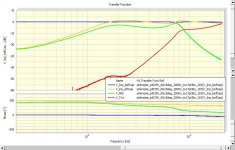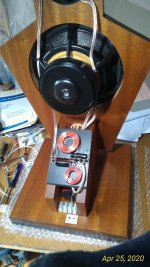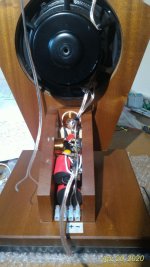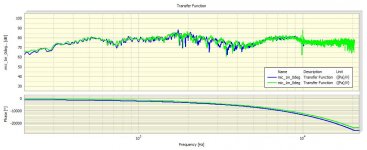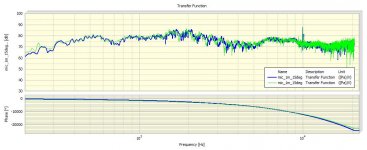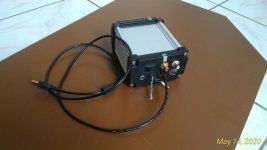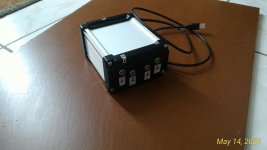Probably the right way to go - see you in the LX521 resources section (my user name is the same if you wouldn't mind giving me a nudge)
I'm conflicted on how much to say on this topic. 🙂 I will probably post something on the OPLUG soon.
Dave.
I will be looking forward to that. I just bought the LX521 plans and have an unused MiniDSP 4 x 10HD ready to go. My wife is much more accepting of the LX521.4 design than the LXMinis, which she calls my “spy camera speakers” But she cannot deny their great sound.
My first glance through the plans looks like SL went through several iterations of MiniDSP crossovers over time...I’ll have to study that history. The dual midrange seems like a peculiar challenge since so much of the vital musical signal is there. Get it wrong and it will be noticed.
A 2 amp solution would be very interesting, since I would have no problem DIY-ing 4 channels but 8-10 seems like a little much unless one went the Hypex module route. I know you have build a Hypex amp, what are your thoughts on that for the 521 system?
—Mark
as stated earlier, the LR4 filter was added in front of the SL's first order filters. Main reason was that I had already soldered SL's cap and inductor and did not feel like vandalizing the setup to insert the LR4s after the cap. However the ripple below the Xover freq has been bugging me so I checked last weekend if moving the LR4 to after the cap would make for any significant difference.
This time I added another measurement point and measured both before and after the SL's cap and then after the LR4 outputs to the upper mid and the tweeter(s).
Here are the transfer functions referencing the input voltage before the SL's cap. The fundamental issue of phase drifting by 90deg up to the LR4 Xover and the joining ripple in mid freq gain stays unchanged. The bump right before the LR4 Xover got more pronounced and for this position the values would probably have to be tweaked a bit. (mind you these are dBs of Voltage attenuation and not sound).
The ripple is already there right after the SL's cap and before the LR4. I followed SL's recommendation to replicate the LR4 active filters, but I cannot help the feeling that for a passive solution an asymmetric filter would have performed better.
Since I do not have a stock of parts and boards configured for making easy (re)connections like a speaker manufacturer does, and since I have my amp work and some preamp upgrades to do, I will probably wrap it up here for the first iteration to get the system going this winter. If I feel after EQ that a further improvement may be possible, I may revisit the Xover down the road and experiment some more for a better result. After all that is the beauty of DIY 😀.
This time I added another measurement point and measured both before and after the SL's cap and then after the LR4 outputs to the upper mid and the tweeter(s).
Here are the transfer functions referencing the input voltage before the SL's cap. The fundamental issue of phase drifting by 90deg up to the LR4 Xover and the joining ripple in mid freq gain stays unchanged. The bump right before the LR4 Xover got more pronounced and for this position the values would probably have to be tweaked a bit. (mind you these are dBs of Voltage attenuation and not sound).
The ripple is already there right after the SL's cap and before the LR4. I followed SL's recommendation to replicate the LR4 active filters, but I cannot help the feeling that for a passive solution an asymmetric filter would have performed better.
Since I do not have a stock of parts and boards configured for making easy (re)connections like a speaker manufacturer does, and since I have my amp work and some preamp upgrades to do, I will probably wrap it up here for the first iteration to get the system going this winter. If I feel after EQ that a further improvement may be possible, I may revisit the Xover down the road and experiment some more for a better result. After all that is the beauty of DIY 😀.
Attachments
Last edited:
Finally put the passive XO together (values as posted before and the XO in front of SL's ind&cap). The upper mid LP packaged inside the base but the tweet HP had to come out on top of the cover 🙁.
Now I have to bring myself to take measurements again to make sure everything was soldered properly and then to EQ that ripple back to flat before adding SL's EQ (kind of a midbass boost?). Then follows the fun part 🙂.
🙂.
Now I have to bring myself to take measurements again to make sure everything was soldered properly and then to EQ that ripple back to flat before adding SL's EQ (kind of a midbass boost?). Then follows the fun part
 🙂.
🙂.Attachments
Finally put the passive XO together (values as posted before and the XO in front of SL's ind&cap). The upper mid LP packaged inside the base but the tweet HP had to come out on top of the cover 🙁.
Now I have to bring myself to take measurements again to make sure everything was soldered properly and then to EQ that ripple back to flat before adding SL's EQ (kind of a midbass boost?). Then follows the fun part🙂.
Great work - you’ve set yourself a challenge there working with those space constraints.
good I retook the measurements. One speaker gave me a fright since the tweeters did not work. It turned out it was a cold solder in the HP section pheeew. The upper mid-to-tweet crossing of frequencies is smooth; however there is a need for some EQ to get it to flat. Here is the overlaid measurement for the left and the right speaker at 0deg and 15deg. The shape of the acoustic response matches that of the voltage response measured earlier, however the change in amplitude is more than I expected so EQ here I come.
Attachments
well I seem to have a problem with the kit version of 2x4 miniDSP balanced (plus miniDigi): the unit is noisy. If only one speaker outputs are used (say channels 1&3), the noise is so-so, but as soon as I plug in the output cable to the preamp on channel 2or4 the noise just goes up significantly. The noise is broadband in nature, kind of white noise in the upper mid driver and not the humming noise at PS 60Hz or 120Hz typical of ground loop issues. I am inclined to think that this is the board layout or component issue. I see quite a few folks complained about the same over years and no constructive feedback was received from miniDSP (who probably knows what the issue is but made the faulty boards and did not want to eat up the cost of a faulty design). My preamps and amps have been used with Oppo player balanced outputs and Elsinore speakers for years and are dead quiet.
Not sure where I will go from here. A big disappointment given that I have been waiting for LX521s to come together for a few years 😡.
Not sure where I will go from here. A big disappointment given that I have been waiting for LX521s to come together for a few years 😡.
I have never used those "original" minidsp 2x4 boards/units, but my 4x10HD and 2x4HD boxed units don't have noise issues. But I had elevated noise in all channels with a semi-broken AC power supply unit of 4x10HD.
I have heard the same as Juhazi - 4x10HD doesn't have this issue. The other option is:
freeDSP-aurora - DSP with 8 I/Os, USB Audio, S/P-DIF, ADAT, Bluetooth and Wifi contro
Aurora DSP – auverdion
Which I nearly went down the route of using this, but am still favouring an analogue crossover or ASP.
I guess you won't need a full 8 channels since you're only going to eq out certain portions of the whole signal?
freeDSP-aurora - DSP with 8 I/Os, USB Audio, S/P-DIF, ADAT, Bluetooth and Wifi contro
Aurora DSP – auverdion
Which I nearly went down the route of using this, but am still favouring an analogue crossover or ASP.
I guess you won't need a full 8 channels since you're only going to eq out certain portions of the whole signal?
apparently there have been A LOT of complaints about the balanced kit version of 2x4:
Minidsp with high efficiency speakers; noise?
some even analyzed the noise in the circuit (use Google translate on the Dutch forum:
Ruis MiniDSP Balanced - forum.zelfbouwaudio.nl
miniDSP team argued on all forums that with the proper gain structure the noise should be acceptable. I am not sure I understand this since I normally use Oppo 105 as a source with 4.2Vrms dBu on the balanced outputs and miniDSP should have 4Vrms at best. Anyways I will open Aleph P and use the dip switch at its input to get attenuation and turn it into a buffered volume control with no gain.
They also argued that the digital gain attenuation should not be used. So I will see that I eliminate it (I have a separate analog volume control on bass and high/mid channels since each has an Aleph P before the amp).
a few guys ended up using a 1:1 transformer but I do not see how that can help past the LP filtering due to a limited bandwidth of the transformer? plus the transformer would bring in its own flavour across the audio range.
I also have 4x10Hd in my other system with no issues running unbalanced. I would have to buy more XLR connectors to make cables and move the unit to try it. However that one will stay dedicated to my 3-way active OBs so it really would not solve my problem.
I have put this unit together years ago to use in such an application:
Minidsp with high efficiency speakers; noise?
some even analyzed the noise in the circuit (use Google translate on the Dutch forum:
Ruis MiniDSP Balanced - forum.zelfbouwaudio.nl
miniDSP team argued on all forums that with the proper gain structure the noise should be acceptable. I am not sure I understand this since I normally use Oppo 105 as a source with 4.2Vrms dBu on the balanced outputs and miniDSP should have 4Vrms at best. Anyways I will open Aleph P and use the dip switch at its input to get attenuation and turn it into a buffered volume control with no gain.
They also argued that the digital gain attenuation should not be used. So I will see that I eliminate it (I have a separate analog volume control on bass and high/mid channels since each has an Aleph P before the amp).
a few guys ended up using a 1:1 transformer but I do not see how that can help past the LP filtering due to a limited bandwidth of the transformer? plus the transformer would bring in its own flavour across the audio range.
I also have 4x10Hd in my other system with no issues running unbalanced. I would have to buy more XLR connectors to make cables and move the unit to try it. However that one will stay dedicated to my 3-way active OBs so it really would not solve my problem.
I have put this unit together years ago to use in such an application:
Attachments
and I only use 4 channels since I have passive Xover on mid/high baffle so bi-amping is the goal i.e. an LX521.2.
Finally put the passive XO together (values as posted before and the XO in front of SL's ind&cap). The upper mid LP packaged inside the base but the tweet HP had to come out on top of the cover 🙁.
Now I have to bring myself to take measurements again to make sure everything was soldered properly and then to EQ that ripple back to flat before adding SL's EQ (kind of a midbass boost?). Then follows the fun part🙂.
Hi could you share the crossover values again?
XO values in post 54
currently restoring a vintage tube amp to run my LX521s 😀
https://www.diyaudio.com/forums/tubes-valves/330062-d150-monster-amp-funny-tooobz-13.html#post6502306
currently restoring a vintage tube amp to run my LX521s 😀
https://www.diyaudio.com/forums/tubes-valves/330062-d150-monster-amp-funny-tooobz-13.html#post6502306
- Home
- Loudspeakers
- Multi-Way
- Crossover for Linkwitz LX521
